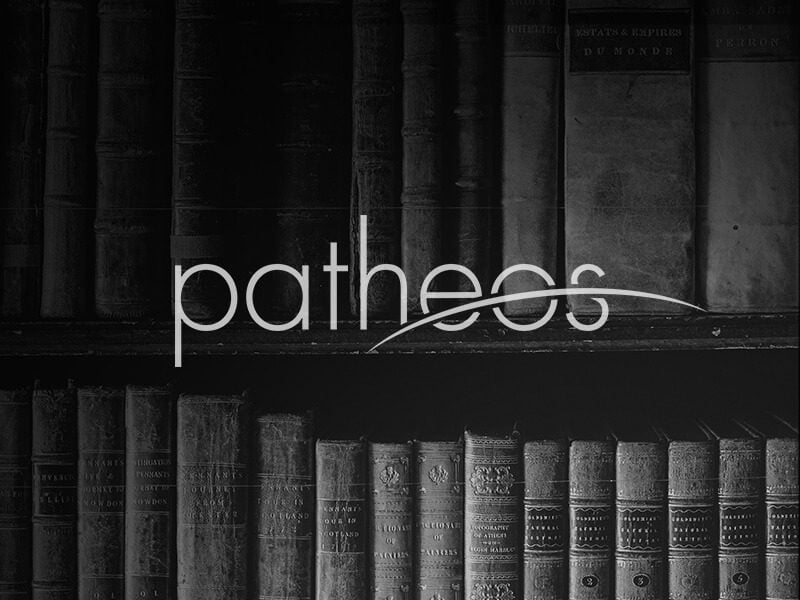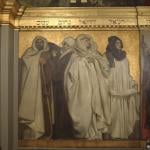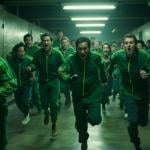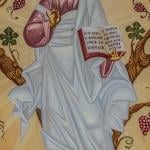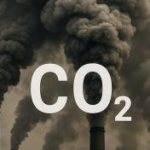
Of all the Church’s dubious pious traditions, my favorite is the story of the Veronica Veil. According to the Acts of Pilate, while Jesus was being goaded and driven to Calvary, under the weight of His Cross, a woman stepped forward and mopped His face with her veil. Miraculously, the face’s image was transferred to the fabric. She later brought the veil to Rome, where it cured the Emperor Tiberias.
The name “Veronica,” which appears in the text, is a Latinized version of the Greek name “Berenike,” or “bearer of victory” — rendered hideously in English as “Bernice.” However, the Catholic Encyclopedia says that the name began as a portmanteau of the Latin words “vera icona,” or “true image,” and referred to the relic of the veil before settling on the person. Whatever its derivation, “Veronica” works better than “Betty.”
If this is balderdash, then it’s the Belvedere of balderdash — a story so good that it ought to be true even if it isn’t. Veronica’s character shows real consistency, especially considering Acts of Pilate identifies her as the woman who, according to Luke, cured her hemorrhages with her faith, and by touching the hem of Jesus’ robe. Quite a gutsy dame, is Veronica. Her faith drives her ever forward — into action, and perhaps, into trouble. Whenever she sees something that needs doing — whether it’s healing herself, swabbing the Messiah’s burning brow, or witnessing to the ruler of the civilized world — she goes for it.
It’s fun to note that Nike — the Greek word for “victory,” which appears it Veronica’s name — tells consumers: “Just do it.” This could have been Veronica’s own motto. In bullfighting, a type of matador’s pass is called a “veronica” — yes, named after the valiant lady of Jerusalem. The bull, like the Lamb, ends up getting his face wiped.
What makes Veronica’s story plausible is the fact that people really do act that way, performing sudden acts of courage and charity. September 11 abounded with those episodes. In the New York Times, Jim Dwyer calls it “an hour of human decency.” He tells of how a man named Keating Crown, injured by the impact of the second plane and forced to hobble down 78 flights on a broken leg, met a stranger, who tore a strip off his shirt and bandaged one of his wounds. Dwyer continues:
If humankind had an army, that bloody cloth on Keating Crown’s head could have flown as its flag, and that stranger on the Bowery would have been its quartermaster.
Between 14,000 and 17,000 people in the towers, old and young, fat and fit, able-bodied and not, marshaled themselves into evacuations that were undirected, unrehearsed and orderly. A firm hand on an elbow, giving strength to wobbly legs. A soothing voice that said chemotherapy was hard but these are just stairs and you can do it. The double-file line of strangers that folded into a single line to make way for someone who had to get down first.
I had my own Veronica moment on September 11. Characteristically, it was minor and entirely PC. I was working at the worst of my post-grad school jobs, cold-calling for a debt consolidation agency. Since Phoenix is on Pacific Standard Time from April through October, we arrived at work some time after the Towers had come down. The company was small, and occupied a suite of offices in a converted motel that looked as seedy as the operation was in fact. I remember standing on the balcony, in front of the entrance, chain-smoking and wondering who could think about his debts with the whole world coming down around his ears.
The owner must have had his own debts in mind. When he came up the stairs, he boomed, in official tones, “ALL RIGHT, PEOPLE. YOU HEARD THE NEWS: NO MORE WORLD TRADE CENTER. NOW LET’S GET ON THE PHONES AND MAKE SOME CHEESE.” Our reluctance must have showed, because he added, in a more subdued voice, “If anyone gives you a hard time for bothering them during a time of national emergency, just tell them, ‘We have to get on with our lives, or else the terrorists win.’”
It was not a good business day. Each of us got a share of the rage that should rightfully have gone to Osama bin Laden. But then, that’s a salesman’s lot. The only civil encounter I had was with a man in Los Angeles who had an Arabic name. I’m not feeling very imaginative today, so I’ll call him “Muhammad.” On the surface, I delivered the standard pitch; he raised objections, which I answered. He agreed to the deal; I confirmed his contact information and took his credit card number. A slam dunk, as far as those things went.
But there was a powerful subtext. Though Muhammad’s voice was steady, it sounded hollow. It was obvious that events of that day had bruised his soul, no less than they had those of the people who called us traitors and parasites, and claimed to have bedded our parents. I got the impression that, for him, paying $400 to have his credit ruined was a pledge of allegiance, a proof of loyalty to America and her economy. By maintaining a casual tone, by speaking his name with no hostile accents, I tried to reassure him that the American tradition of pluralism would hold firm. There would be no internments, no pogroms, just a call back from our verifications department and a charge on his Discover.
The son of a bitch ended up cancelling his order. No matter — the whole week was slow. I wouldn’t have earned above my hourly in any case. What I did get — what Muhammad and I both got — was a human encounter, a moment of understated tenderness to last us through the worst day of the decade.
Not quite a face-wiping or a wound-bandaging, but not bad for long-distance.





